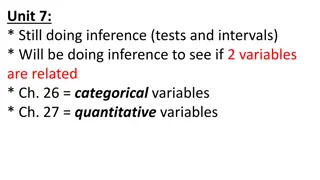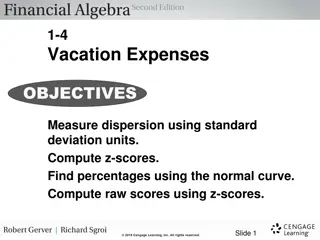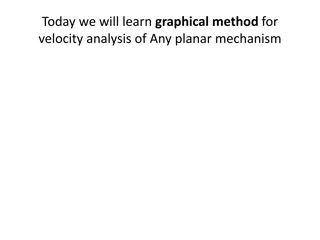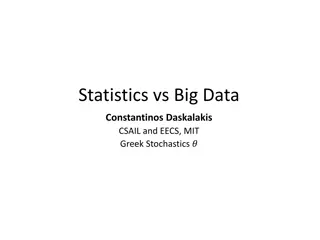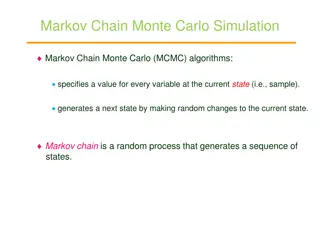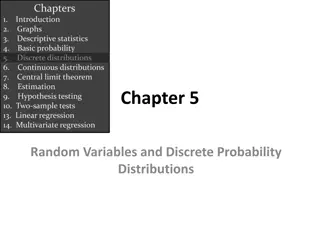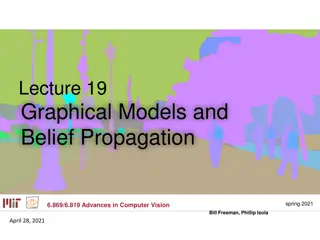Graphical Methods for Data Distributions
In this chapter, Kathy Fritz presents graphical methods for describing data distributions. It covers variables, data types (univariate, bivariate, multivariate), categorical and numerical variables, and their characteristics. Understand the distinctions between different types of data and variables, such as qualitative and quantitative. Explore the significance of numerical variables, including discrete and continuous types, and the reason for performing mathematical operations on them. Gain knowledge on how to interpret and visualize data effectively.
Download Presentation

Please find below an Image/Link to download the presentation.
The content on the website is provided AS IS for your information and personal use only. It may not be sold, licensed, or shared on other websites without obtaining consent from the author.If you encounter any issues during the download, it is possible that the publisher has removed the file from their server.
You are allowed to download the files provided on this website for personal or commercial use, subject to the condition that they are used lawfully. All files are the property of their respective owners.
The content on the website is provided AS IS for your information and personal use only. It may not be sold, licensed, or shared on other websites without obtaining consent from the author.
E N D
Presentation Transcript
Chapter 2 Graphical Methods for Describing Data Distributions Created by Kathy Fritz
Variable any characteristic whose value may change from one individual to another College Home
Data The values for a variable from individual observations
Suppose that a PE coach records the height of each student in his class. This is an example of a univariate data Univariate consist of observations on a single variable made on individuals in a sample or population
Suppose that the PE coach records the height and weight of each student in his class. This is an example of a bivariate data Bivariate - data that consist of pairs of numbers from two variables for each individual in a sample or population
Suppose that the PE coach records the height, weight, number of sit-ups, and number of push-ups for each student in his class. This is an example of a multivariate data Multivariate - data that consist of observations on two or more variables
Two types of variables categorical numerical
Categorical variables Qualitative Consist of categorical responses 1. Car model 2. Birth year 3. Type of cell phone 4. Your zip code 5. Which club you have joined Which of these variables are NOT categorical variables? They are all categorical variables!
Numerical variables quantitative There are two types of numerical variables - discrete and continuous It makes sense to perform math operations on these values. observations or measurements take on numerical values Which of these variables are NOT numerical? code to combination locks? 1. GPAs 2. Height of students 3. Codes to combination locks 4. Number of text messages per day 5. Weight of textbooks Does it makes sense to find an average
Two types of variables categorical numerical discrete continuous
Discrete (numerical) Isolated points along a number line usually counts of items Example: number of textbooks purchased
Continuous (numerical) Variable that can be any value in a given interval usually measurements of something Example: GPAs
Identify the following variables: 1. the color of cars in the teacher s lot Categorical 2. the number of calculators owned by students at your college Discrete numerical 3. the zip code of an individual Is money a measurement or a count? Categorical 4. the amount of time it takes students to drive to school 5. the appraised value of homes in your city Continuous numerical Discrete numerical
Graphical Display Variable Type Data Type Purpose Display data distribution Compare 2 or more groups Display data distribution Compare 2 or more groups Display data distribution Compare 2 or more groups Display data distribution Investigate relationship between 2 variables Investigate trend over time Univariate Use the following table to determine an appropriate graphical display a data set. Bar Chart Categorical Comparative Bar Chart Univariate for 2 or more groups Categorical What types of graphs can be used with categorical data? Dotplot Univariate Numerical Comparative dotplot Stem-and-leaf display Comparative stem- and-leaf Univariate for 2 or more groups Numerical Univariate Numerical Univariate for 2 groups Numerical In section 2.3, we will see how the various graphical displays for univariate, numerical data compare. Histogram Univariate Numerical Scatterplot Bivariate Numerical Univariate, collected over time Time series plot Numerical
Displaying Categorical Data Bar Charts Comparative Bar Charts
Bar Chart When to Use: Univariate, Categorical data To comply with new standards from the U. S. Department of Transportation, helmets should reach the bottom of the motorcyclist s ears. The report Motorcycle Helmet Use in 2005 Overall Results (National Highway Traffic Safety Administration, August 2005) summarized data collected by observing 1700 motorcyclists nationwide at selected roadway locations. Each time a motorcyclist passed by, the observer noted whether the rider was wearing no helmet (N), a noncompliant helmet (NC), or a compliant helmet (C). category appears in the data set. This is called a frequency distribution. A bar chart is a graphical display for categorical data. A frequency distribution is a table that displays the possible categories along with the associated frequencies or relative frequencies. The frequency for a particular category is the number of times that Helmet Use N NC C Frequency The data are summarized in this table: This should equal the total number of observations. 731 153 816 1700
Bar Chart To compile with new standards from the U. S. Department of Transportation, helmets should reach the bottom of the motorcyclist s ears. The report Motorcycle Helmet Use in 2005 Overall Results (National Highway Traffic Safety Administration, August 2005) summarized data collected by observing 1700 motorcyclists nationwide at selected roadway locations. Each time a motorcyclist passed by, the observer noted whether the rider was wearing no helmet (N), a noncompliant helmet (NC), or a compliant helmet (C). Relative Frequency 0.430 0.090 0.480 The data is summarized in this table: This should equal 1 (allowing for rounding). Helmet Use Helmet Use N NC C C Frequency 731 153 816 1700 1.000 N NC
Bar Chart How to construct 1. Draw a horizontal line; write the categories or labels below the line at regularly spaced intervals the bar are proportional to the frequency or relative frequency of the corresponding categories. All bars should have the same width so that both the height and the area of 2. Draw a vertical line; label the scale using frequency or relative frequency 3. Place a rectangular bar above each category label with a height determined by its frequency or relative frequency
Bar Chart What to Look For Frequently or infrequently occurring categories Here is the completed bar chart for the motorcycle helmet data. Describe this graph.
Comparative Bar Charts When to Use Univariate, Categorical data for two or more groups comparison of two or more groups. than frequency on the vertical axis so that you can make meaningful comparisons even if the sample sizes are not the same. Bar charts can also be used to provide a visual You use relative frequency rather How to construct Constructed by using the same horizontal and vertical axes for the bar charts of two or more groups Usually color-coded to indicate which bars correspond to each group Shoulduse relative frequencies on the vertical axis Why?
Each year the Princeton Review conducts a survey of students applying to college and of parents of college applicants. In 2009, 12,715 high school students responded to the question Ideally how far from home would you like the college you attend to be? Also, 3007 parents of students applying to college responded to the question how far from home would you like the college your child attends to be? Data is displayed in the frequency table below. What should you do first? Frequency Create a comparative bar chart with these data. Ideal Distance Less than 250 miles 250 to 500 miles 500 to 1000 miles More than 1000 miles Students 4450 3942 2416 1907 Parents 1594 902 331 180
Relative Frequency Students .35 .31 .19 .15 Ideal Distance Less than 250 miles 250 to 500 miles 500 to 1000 miles More than 1000 miles Found by dividing the frequency by the total number of students Found by dividing the frequency by the total number of parents Parents .53 .30 .11 .06 What does this graph show about the ideal distance college should be from home?
Displaying Numerical Data Dotplots Stem-and-leaf Displays Histograms
Dotplot When to Use How to construct 1. Draw a horizontal line and mark it with an appropriate numerical scale Univariate, Numerical data 2. Locate each value in the data set along the scale and represent it by a dot. If there are two are more observations with the same value, stack the dots vertically
Dotplot What to Look For A representative or typical value (center) in the data set The extent to which the data values spread out The nature of the distribution (shape) along the number line The presence of unusual values (gaps and outliers) dotplots, stem-and-leaf displays, and histograms. An outlier is an unusually large or small data value. A precise rule for deciding when an observation is an outlier is given in Chapter 3. What we look for with univariate, numerical data sets are similar for
The first three observations are plotted note that you stack the points if values are repeated. Professor Norm gave a 10-question quiz last week in his introductory statistics class. The number of correct answers for each student is recorded below. First draw a horizontal line with an appropriate scale. This is the completed dotplot. 6 8 6 8 5 7 6 4 6 5 6 6 4 7 6 7 7 5 9 3 5 4 8 9 5 7 Write a few sentence describing this distribution. 2 2 4 4 4 6 6 6 8 8 8 10 10 10 2 Number of correct answers Number of correct answers Number of correct answers
What to Look For The representative or typical value (center) in the data set The extent to which the data values spread out The nature of the distribution (shape) along the number line The nature of the distribution (shape) along the number line vertical line of symmetry where the left half is smoothing out this What to Look For The representative or typical value (center) in the data set The extent to which the data values spread out The nature of the distribution (shape) along the number line The presence of unusual values The presence of unusual values The presence of unusual values a mirror image of the right half. dotplot, we will see that there is ONLY one peak. What to Look For The representative or typical value (center) in the data set The extent to which the data values spread out A symmetrical distribution is one that has a If we draw a curve, Professor Norm gave a 10-question quiz last week in his introductory statistics class. The number of correct answers for each student is recorded below. Distributions with a single peak are said to be unimodal. 2 Number of correct answers 4 6 8 10 The center for the distribution of the number of The center for the distribution of the number of correct answers is about 6. There is not a lot of with more than two peaks are multimodal. The center for the distribution of the number of correct answers is about 6. correct answers is about 6. There is not a lot of variability in the observations. variability in the observations. The distribution is approximately symmetrical with no unusual observations. Distributions with two peaks are bimodal, and
Comparative Dotplots When to Use Univariate, numerical data with observations from 2 or more groups How to construct Constructed using the same numerical scale for two or more dotplots Be sure to include group labels for the dotplots in the display What to Look For Comment on the same four attributes, but comparing the dotplots displayed.
Create a comparative dotplot with the data sets from the two statistics classes, Professors Norm and Skew. Is the distribution for Prof. Skew s class Distributions where the right tail is longer than the left is said to be positively skewed (or skewed to the right). In another introductory statistics class, Professor Skew also gave a 10-question quiz. The number of correct answers for each student is recorded below. symmetric? Why or why not? The direction of skewness is always in the direction of the longer tail. 6 8 8 8 7 7 10 8 6 8 9 6 8 7 6 7 7 5 9 3 5 8 8 9 10 7 8 The center of the distribution for the number of correct answers on Prof. Skew s class is largerthan the center of Prof. Norm s class. There is also morevariability in Prof. Skew s distribution. Prof. Skew s distribution appears to have an unusual observation where one student only had 2 answers correct while there were no unusual observations in Prof. Norm s class. The distribution for Prof. Skew is negatively skewed while Prof. Norm s Prof. Skew Write a few sentences comparing these distributions. distribution is more symmetrical. Notice that the left side (or lower tail) of the distribution is longer than the right side (or upper tail). This distribution is said to be negatively skewed (or skewed to the left). Prof. Norm 2 Number of correct answers 4 6 8 10
Stem-and-Leaf Displays When to Use Univariate, Numerical data How to construct Select one or more of the leading digits for the stem List the possible stem values in a vertical column Record the leaf for each observation beside the corresponding stem value Indicate the units for stems and leaves someplace in the display Stem-and-leaf displays are an effective way to summarize univariate numerical data when the data set is not too large. Each observation is split into two parts: Stem consists of the first digit(s) Leaf - consists of the final digit(s) Be sure to list every stem from the smallest to the largest value
Stem-and-Leaf Displays What to Look For A representative or typical value (center) in the data set The extent to which the data values spread out The presence of unusual values (gaps and outliers) The extent of symmetry in the data distribution The number and location of peaks
iPhone 5 pictures and parts leaked So the leaf will be the last two digits. below. The completed stem-and-leaf display is shown The article Going Wireless (AARP Bulletin, June 2009) reported the estimated percentage of households with only wireless phone service (no landline) for the 50 U.S. states and the District of Columbia. Data for the 19 Eastern states are given here. 5.6 5.7 20.0 16.8 16.5 11.4 16.3 14.0 10.8 7.8 Let 5.6% be represented as 05.6% so that all the numbers have two digits in front of the decimal. If we use the 2-digits, we would have stems from 05 to 20 that s way too many stems! So let s just use the first digit (tens) as our stems. number, 5.7 also is written behind the stem 0 (with a in the leaf. With 05.6%, the leaf is 5.6 and it will be written behind the stem 0. For the second However, it is somewhat difficult to read due to the 2-digit stems. A common practice is to drop all but the first digit comma between). 13.4 20.6 What is the leaf for 20.0% and where should that leaf be written? easier to read, but DOES NOT change the overall distribution of the data set. 10.8 10.8 9.3 5.1 11.6 11.6 8.0 A stem-and-leaf display is an appropriate way to summarize these data. 0.0 0.0, 0.6 0 0 What is the variable of interest? This makes the display 0 1 2 2 2 2 2 0 0 0 0 1 1 1 1 5.6, 5.7 5.6, 5.7 5.6, 5.7, 9.3, 8.0, 7.8, 5.1 6.8, 6.5, 3.4, 0.8, 1.6, 1.4, 6.3, 4.0, 0.8, 0.8, 1.6 6 6 3 0 1 1 6 4 0 0 1 5 5 9 8 7 5 Wireless percent (A dotplot would also be a reasonable choice.)
iPhone 5 pictures and parts leaked The article Going Wireless (AARP Bulletin, June 2009) reported the estimated percentage of households with only wireless phone service (no landline) for the 50 U.S. states and the District of Columbia. Data for the 19 Eastern states are given here. The center of the distribution for the estimated percentage of households with only wireless phone service is approximately 11%. There does not appear to be much variability. This display appears to be a unimodal, symmetric distribution with no outliers. While it is not necessary to write the leaves in order from smallest to largest, by doing so, the center of the distribution is more easily seen. 5 5 9 8 7 5 6 6 3 0 1 1 6 4 0 0 1 0 0 0 0 Stem: tens Leaf: ones Write a few sentences describing this distribution. 0 1 2 2 0 1 5 5 5 7 8 9 0 0 0 1 1 1 3 4 6 6 6
Comparative Stem-and-Leaf Displays When to Use Univariate, numerical data with observations from 2 or more group How to construct List the leaves for one data set to the right of the stems List the leaves for the second data set to the left of the stems Be sure to include group labels to identify which group is on the left and which is on the right
iPhone 5 pictures and parts leaked The article Going Wireless (AARP Bulletin, June 2009) reported the estimated percentage of households with only wireless phone service (no landline) for the 50 U.S. states and the District of Columbia. Data for the 13 Western states are given here. 11.7 18.9 9.0 16.7 21.1 17.7 25.5 16.3 Western States Eastern States 5 5 5 7 8 9 0 0 0 1 1 1 3 4 6 6 6 0 0 Stem: tens Leaf: ones 9 9 8 0 1 2 8 7 6 6 1 1 0 8.0 11.4 22.1 9.2 10.8 5 2 1 Create a comparative stem- and-leaf display comparing the distributions of the Eastern and Western states. The center of the distribution of the estimated percentage of households with only wireless phone service for the Western states is a little larger than the center for the Eastern states. Both distributions are Write a few sentences comparing these distribution. symmetrical with approximately the same amount of variability.
Histograms When to Use Dotplots and stem-and-leaf displays are not effective ways to summarize numerical data when the data set contains a large number of data values. always result from counting. In such cases, each observation is a Univariate numerical data How to construct Draw a horizontal scale and mark it with the possible values for the variable Draw a vertical scale and mark it with frequency or relative frequency Above each possible value, draw a rectangle centered at that value with a height corresponding to its frequency or relative frequency What to look for Center or typical value; spread; general shape and location and number of peaks; and gaps or outliers Discrete data Constructed differently for discrete versus continuous data Discrete numerical data almost Histogramsare displays that don t work well for small data sets but do work well for larger numerical data sets. whole number
Queen honey bees mate shortly after they become adults. During a mating flight, the queen usually takes multiple partners, collecting sperm that she will store and use throughout the rest of her life. A paper, The Curious Promiscuity of Queen Honey Bees (Annals of Zoology [2001]: 255-265), provided the following data on the number of partners for 30 queen bees. 12 8 9 2 3 7 4 5 5 6 6 4 6 7 7 7 10 4 8 1 6 7 9 7 8 11 7 6 8 10 Here is a dotplot of these data. 2 4 6 8 10 12 Number of Partners
The bars should be centered over the discrete data values and have heights Queen honey bees continued corresponding to the frequency of each data value. 6 Frequency 4 2 2 2 4 4 Number of partners 6 6 8 8 10 10 12 12 0 In practice, histograms for discrete data ONLY show the rectangular bars. We built the histogram on top of the dotplot to show that the bars are centered over the discrete data values and that heights of the bars are at 7 partners and a somewhat large amount of The variable, number of partners, is discrete. To create a histogram: we already have a horizontal axis we need to add a vertical axis for frequency the frequency of each data value. variability. There doesn t appear to be any outliers. The distribution for the number of partners of queen honey bees is approximately symmetric with a center
Here are two histograms showing the queen bee data set . One uses frequency What do you notice about the shapes of these two histograms? on the vertical axis, while the other uses relative frequency
Histograms with equal width intervals When to Use How to construct Mark the boundaries of the class intervals on the horizontal axis Use either frequency or relative frequency on the vertical axis Draw a rectangle for each class interval directly above that interval. The height of each rectangle is the frequency or relative frequency of the corresponding interval What to look for Center or typical value; spread; general shape and location and number of peaks; and gaps or outliers Univariate numerical data Continuous data
The top dotplot shows all the data values in each interval stacked in the middle of the interval. Consider the following data on carry-on luggage weight for 25 airline passengers. With continuous data, the rectangular bars cover an interval of data values (not just one value). Looking at this dotplot, it is easy to see that we could use intervals with a width of 5. This interval includes 10 and all values up to but not including 15. The next intervals will include 15 and all values up to but not including 20, and so on. 25.0 28.0 22.4 17.9 31.4 24.9 10.1 20.9 26.4 27.6 33.8 22.0 30.0 27.6 34.5 18.0 21.9 22.7 28.7 19.9 25.3 28.2 20.8 27.8 28.5 Here is a dotplot of this data set. This is a continuous numerical data set.
From the dotplot, it is easy to see how the continuous histogram is created.
Comparative Histograms The article Early Television Exposure and Subsequent Attention Problems in Children (Pediatrics, April 2004) investigated the television viewing habits of U.S. children. These graphs show year-old children falling in the 0-2 TV hours interval than 1-year-old children. The biggest difference between the two histograms is at the low end, with a much higher proportion of 3- Must use two separate histograms with the same horizontal axis and relative frequency on the vertical axis the viewing habits of 1-year old and 3-year old children. 1-yr-olds 3-yr-olds
Histograms with unequal width intervals When to use when you have a concentration of data in the middle with some extreme values How to construct construct similar to histograms with continuous data, but with density on the vertical axis relative frequency for interval density = width interval of
When people are asked for the values such as age or weight, they sometimes shade the truth in their responses. The article Self-Report of Academic Performance (Social Methods and Research [November 1981]: 165-185) focused on SAT scores and grade point average (GPA). For each student in the sample, the difference between reported GPA and actual GPA was determined. Positive differences resulted from individuals reporting GPAs larger than the correct value. Interval -2.0 to < -0.4 0.023 -0.4 to < -0.2 0.055 -0.2 to < 0.1 0.097 -0.1 to < 0 0.210 0 to < 0.1 0.189 0.1 to 0.2 0.139 0.2 to < 0.4 0.116 0.4 to 2.0 0.171 When using relative frequency on the vertical axis, the proportional area principle is violated. Notice the relative frequency for the interval 0.4 to < 2.0 is smaller than the relative frequency for the interval -0.1 to < 0, but the area of the bar is MUCH larger. Class Relative Frequency
GPAs continued Class Interval -2.0 to < -0.4 -0.4 to < -0.2 -0.2 to < 0.1 -0.1 to < 0 0 to < 0.1 0.1 to 0.2 0.2 to < 0.4 0.4 to 2.0 Relative Frequency 0.023 0.055 0.097 0.210 0.189 0.139 0.116 0.171 Width Density To fix this problem, we need to find the density of each interval. 1.6 0.2 0.1 0.1 0.1 0.1 0.2 1.6 0.014 0.275 0.970 2.100 1.890 1.390 0.580 0.107 relative frequency for interval density = width interval of This is a correct histogram with unequal widths.
Cumulative Relative Frequency Plots When to use when you want to show the approximate proportion of data at or below any given value How to construct 1. Mark the boundaries of the class intervals on a horizontal axis 2. Add a vertical axis with a scale that goes from 0 to 1 3. For each class interval, plot the point that is represented by (upper endpoint of interval, cumulative relative frequency) 4. Add the point to represented by (lower endpoint of first interval, 0) 5. Connect consecutive points in the display with line segments
Cumulative Relative Frequency Plots What to Look For Proportion of data falling at or below any given value along the x axis The cumulative relative frequency of a given interval is the sum of the current relative frequency and all the previous relative frequencies.
Cumulative relative frequency = Current relative frequency + The National Climatic Data Center has been collecting weather data for many years. A frequency distribution for annual rainfall totals for Albuquerque, New Mexico, from 1950 to 2008 are shown in the table below. Annual Rainfall (inches) Frequency 4 to < 5 3 5 to < 6 6 6 to < 7 5 7 to < 8 6 8 to < 9 10 9 to < 10 4 10 to < 11 12 11 to < 12 6 12 to < 13 3 13 to < 14 3 relative frequency = frequency/58 Previous relative frequency Relative Cumulative Relative Frequency 0.052 0.155 0.241 0.344 Frequency 0.052 0.103 0.086 0.103 0.172 0.069 0.207 0.103 0.052 0.052 + + 0.516 0.585 0.792 0.895 0.947 0.999
To create the cumulative relative frequency plot: Plot the point: The National Climatic Data Center has been collecting weather for many years. The frequency of the annual rainfall totals for Albuquerque, New Mexico, from 1950 to 2008 are shown in the table below. Annual Rainfall (inches) Frequency 4 to < 5 3 5 to < 6 6 6 to < 7 5 7 to < 8 6 8 to < 9 10 9 to < 10 4 10 to < 11 12 11 to < 12 6 12 to < 13 3 13 to < 14 3 Plot the point (upper value of the interval, cumulative relative frequency of the interval) (smallest value of the first interval, 0) Relative Cumulative Relative Frequency 0.052 0.155 0.241 0.344 Frequency 0.052 0.103 0.086 0.103 0.172 0.069 0.207 0.103 0.052 0.052 0.516 0.585 0.792 0.895 0.947 0.999









